Communication Barrier with Indigenous Australians Assessment 2022
VerifiedAdded on 2022/09/16
|8
|1894
|17
AI Summary
Contribute Materials
Your contribution can guide someone’s learning journey. Share your
documents today.
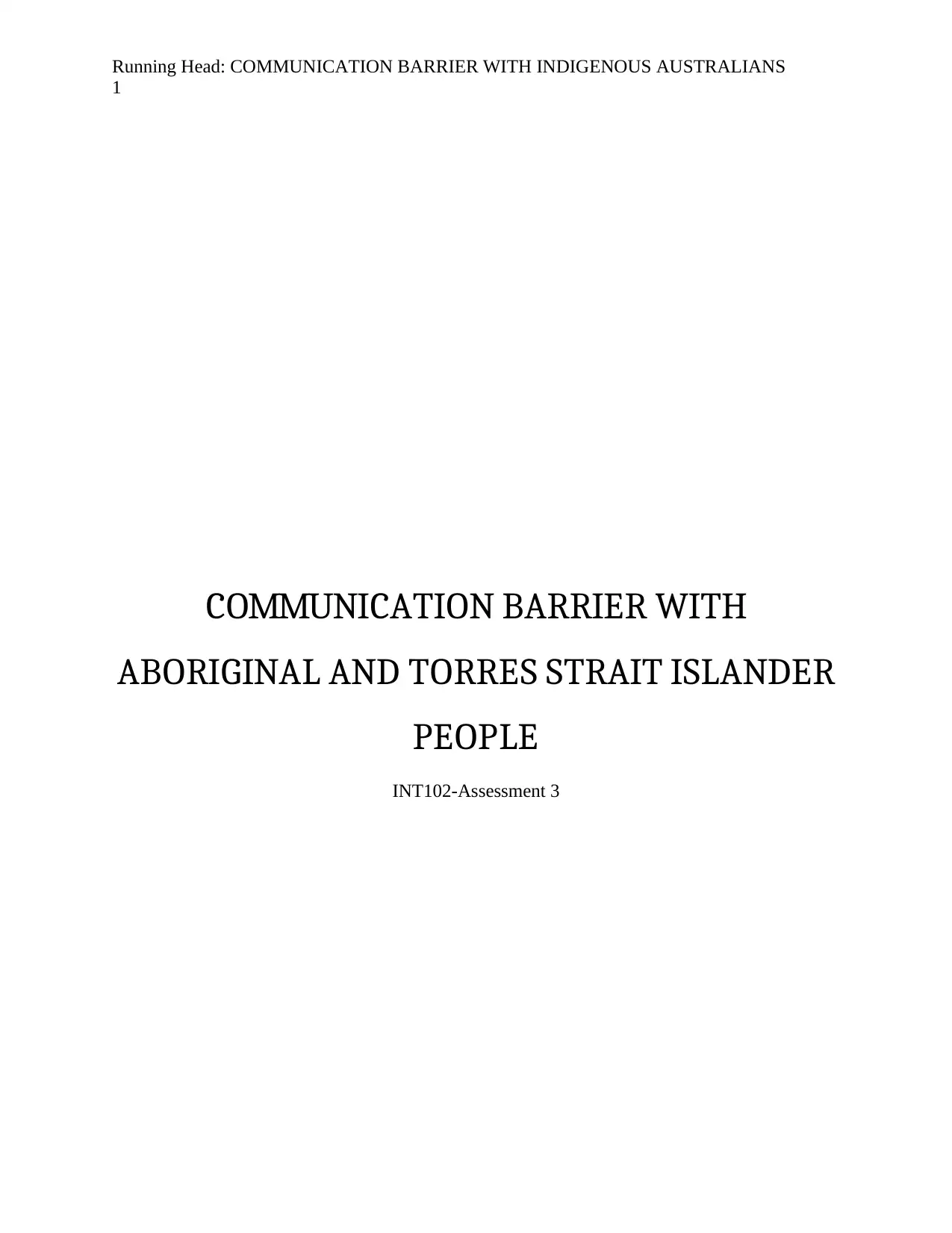
Running Head: COMMUNICATION BARRIER WITH INDIGENOUS AUSTRALIANS
1
COMMUNICATION BARRIER WITH
ABORIGINAL AND TORRES STRAIT ISLANDER
PEOPLE
INT102-Assessment 3
1
COMMUNICATION BARRIER WITH
ABORIGINAL AND TORRES STRAIT ISLANDER
PEOPLE
INT102-Assessment 3
Secure Best Marks with AI Grader
Need help grading? Try our AI Grader for instant feedback on your assignments.
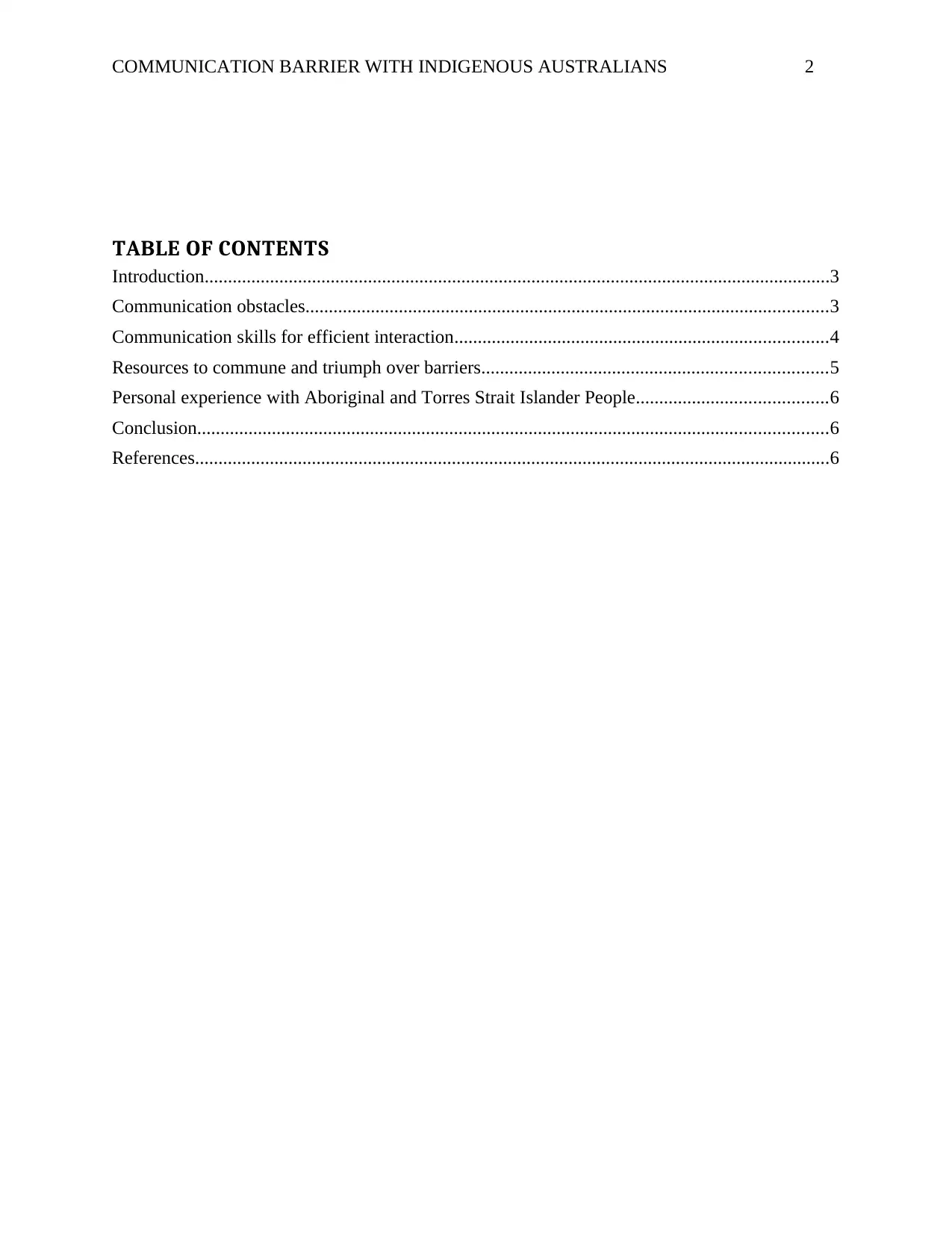
COMMUNICATION BARRIER WITH INDIGENOUS AUSTRALIANS 2
TABLE OF CONTENTS
Introduction......................................................................................................................................3
Communication obstacles................................................................................................................3
Communication skills for efficient interaction................................................................................4
Resources to commune and triumph over barriers..........................................................................5
Personal experience with Aboriginal and Torres Strait Islander People.........................................6
Conclusion.......................................................................................................................................6
References........................................................................................................................................6
TABLE OF CONTENTS
Introduction......................................................................................................................................3
Communication obstacles................................................................................................................3
Communication skills for efficient interaction................................................................................4
Resources to commune and triumph over barriers..........................................................................5
Personal experience with Aboriginal and Torres Strait Islander People.........................................6
Conclusion.......................................................................................................................................6
References........................................................................................................................................6
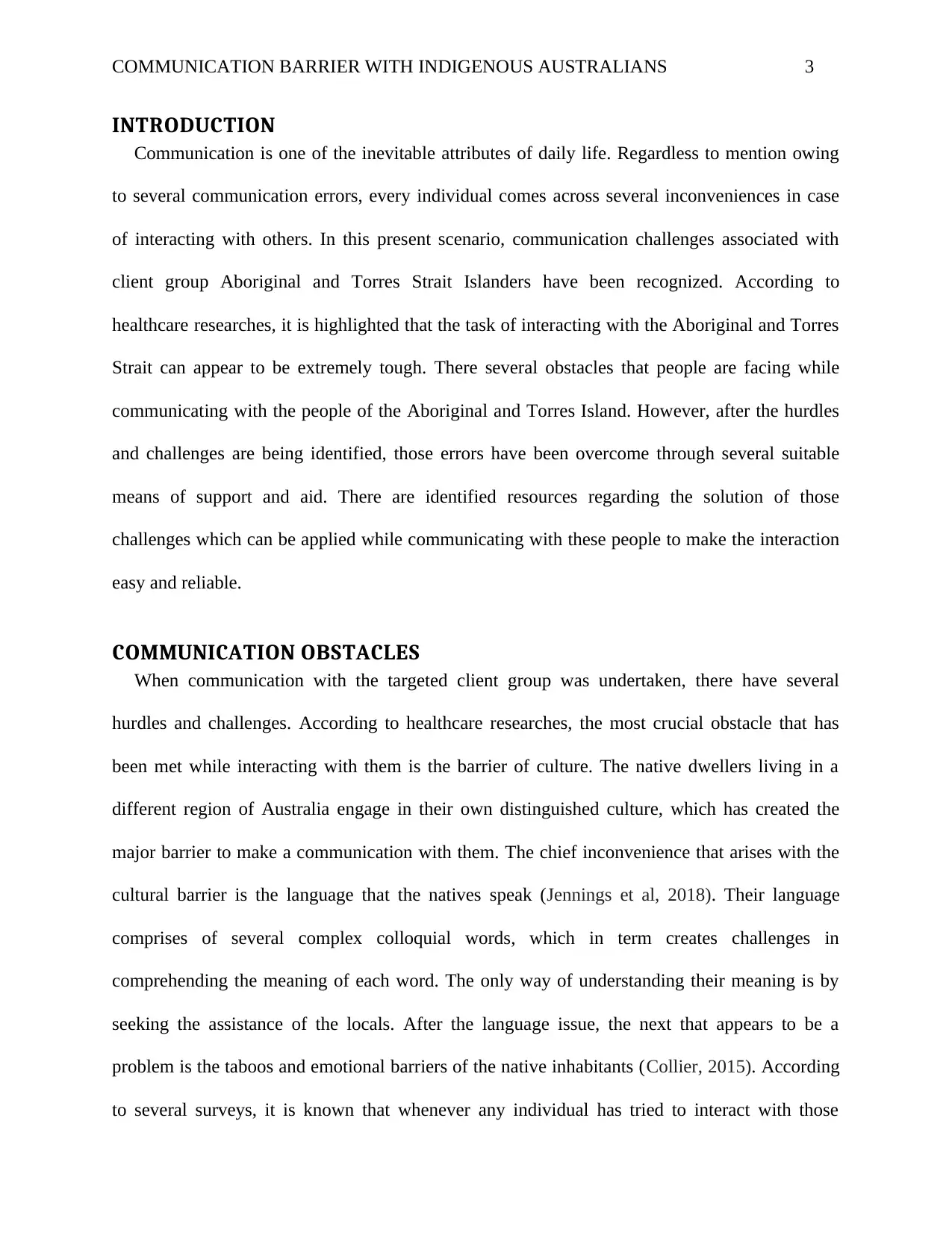
COMMUNICATION BARRIER WITH INDIGENOUS AUSTRALIANS 3
INTRODUCTION
Communication is one of the inevitable attributes of daily life. Regardless to mention owing
to several communication errors, every individual comes across several inconveniences in case
of interacting with others. In this present scenario, communication challenges associated with
client group Aboriginal and Torres Strait Islanders have been recognized. According to
healthcare researches, it is highlighted that the task of interacting with the Aboriginal and Torres
Strait can appear to be extremely tough. There several obstacles that people are facing while
communicating with the people of the Aboriginal and Torres Island. However, after the hurdles
and challenges are being identified, those errors have been overcome through several suitable
means of support and aid. There are identified resources regarding the solution of those
challenges which can be applied while communicating with these people to make the interaction
easy and reliable.
COMMUNICATION OBSTACLES
When communication with the targeted client group was undertaken, there have several
hurdles and challenges. According to healthcare researches, the most crucial obstacle that has
been met while interacting with them is the barrier of culture. The native dwellers living in a
different region of Australia engage in their own distinguished culture, which has created the
major barrier to make a communication with them. The chief inconvenience that arises with the
cultural barrier is the language that the natives speak (Jennings et al, 2018). Their language
comprises of several complex colloquial words, which in term creates challenges in
comprehending the meaning of each word. The only way of understanding their meaning is by
seeking the assistance of the locals. After the language issue, the next that appears to be a
problem is the taboos and emotional barriers of the native inhabitants (Collier, 2015). According
to several surveys, it is known that whenever any individual has tried to interact with those
INTRODUCTION
Communication is one of the inevitable attributes of daily life. Regardless to mention owing
to several communication errors, every individual comes across several inconveniences in case
of interacting with others. In this present scenario, communication challenges associated with
client group Aboriginal and Torres Strait Islanders have been recognized. According to
healthcare researches, it is highlighted that the task of interacting with the Aboriginal and Torres
Strait can appear to be extremely tough. There several obstacles that people are facing while
communicating with the people of the Aboriginal and Torres Island. However, after the hurdles
and challenges are being identified, those errors have been overcome through several suitable
means of support and aid. There are identified resources regarding the solution of those
challenges which can be applied while communicating with these people to make the interaction
easy and reliable.
COMMUNICATION OBSTACLES
When communication with the targeted client group was undertaken, there have several
hurdles and challenges. According to healthcare researches, the most crucial obstacle that has
been met while interacting with them is the barrier of culture. The native dwellers living in a
different region of Australia engage in their own distinguished culture, which has created the
major barrier to make a communication with them. The chief inconvenience that arises with the
cultural barrier is the language that the natives speak (Jennings et al, 2018). Their language
comprises of several complex colloquial words, which in term creates challenges in
comprehending the meaning of each word. The only way of understanding their meaning is by
seeking the assistance of the locals. After the language issue, the next that appears to be a
problem is the taboos and emotional barriers of the native inhabitants (Collier, 2015). According
to several surveys, it is known that whenever any individual has tried to interact with those
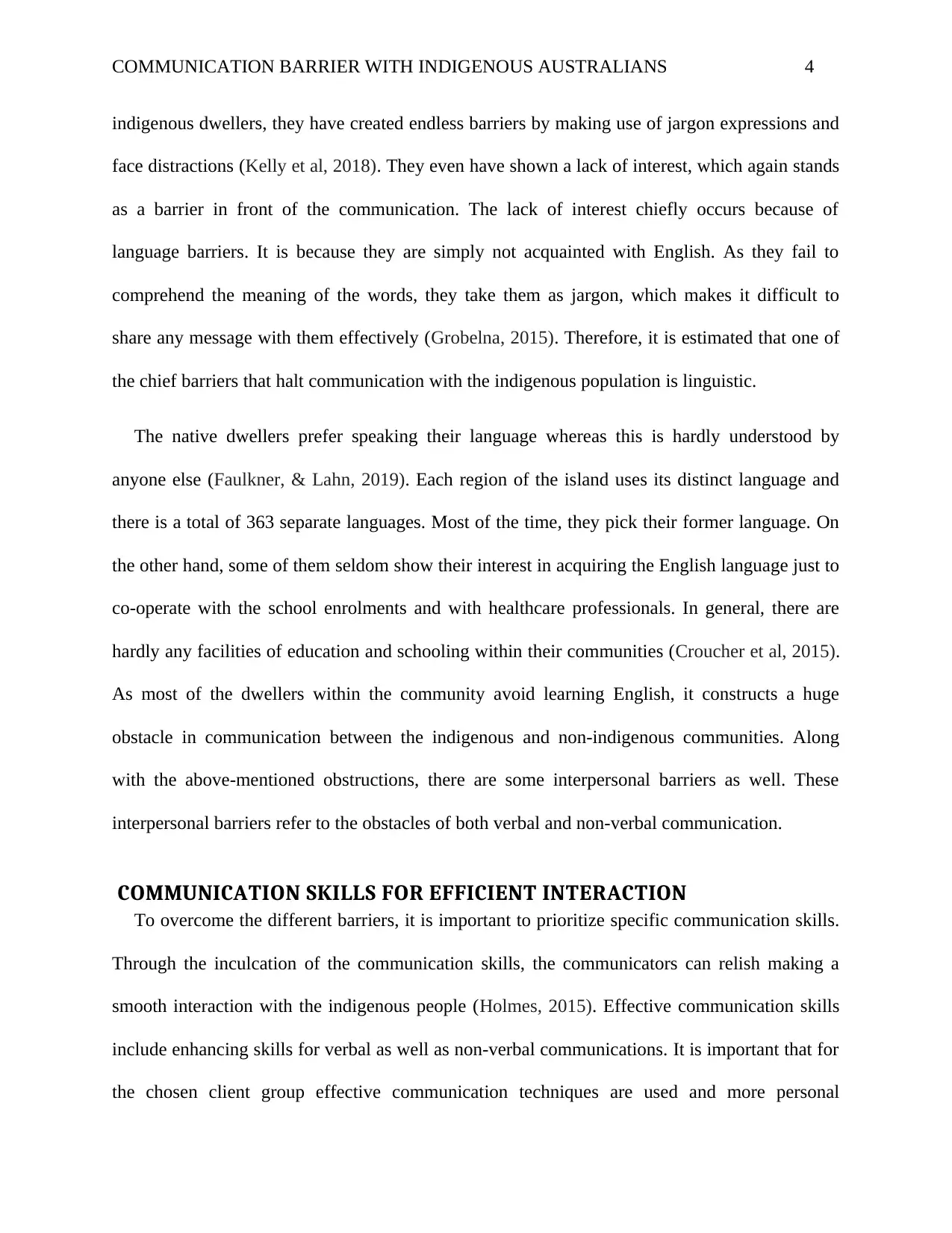
COMMUNICATION BARRIER WITH INDIGENOUS AUSTRALIANS 4
indigenous dwellers, they have created endless barriers by making use of jargon expressions and
face distractions (Kelly et al, 2018). They even have shown a lack of interest, which again stands
as a barrier in front of the communication. The lack of interest chiefly occurs because of
language barriers. It is because they are simply not acquainted with English. As they fail to
comprehend the meaning of the words, they take them as jargon, which makes it difficult to
share any message with them effectively (Grobelna, 2015). Therefore, it is estimated that one of
the chief barriers that halt communication with the indigenous population is linguistic.
The native dwellers prefer speaking their language whereas this is hardly understood by
anyone else (Faulkner, & Lahn, 2019). Each region of the island uses its distinct language and
there is a total of 363 separate languages. Most of the time, they pick their former language. On
the other hand, some of them seldom show their interest in acquiring the English language just to
co-operate with the school enrolments and with healthcare professionals. In general, there are
hardly any facilities of education and schooling within their communities (Croucher et al, 2015).
As most of the dwellers within the community avoid learning English, it constructs a huge
obstacle in communication between the indigenous and non-indigenous communities. Along
with the above-mentioned obstructions, there are some interpersonal barriers as well. These
interpersonal barriers refer to the obstacles of both verbal and non-verbal communication.
COMMUNICATION SKILLS FOR EFFICIENT INTERACTION
To overcome the different barriers, it is important to prioritize specific communication skills.
Through the inculcation of the communication skills, the communicators can relish making a
smooth interaction with the indigenous people (Holmes, 2015). Effective communication skills
include enhancing skills for verbal as well as non-verbal communications. It is important that for
the chosen client group effective communication techniques are used and more personal
indigenous dwellers, they have created endless barriers by making use of jargon expressions and
face distractions (Kelly et al, 2018). They even have shown a lack of interest, which again stands
as a barrier in front of the communication. The lack of interest chiefly occurs because of
language barriers. It is because they are simply not acquainted with English. As they fail to
comprehend the meaning of the words, they take them as jargon, which makes it difficult to
share any message with them effectively (Grobelna, 2015). Therefore, it is estimated that one of
the chief barriers that halt communication with the indigenous population is linguistic.
The native dwellers prefer speaking their language whereas this is hardly understood by
anyone else (Faulkner, & Lahn, 2019). Each region of the island uses its distinct language and
there is a total of 363 separate languages. Most of the time, they pick their former language. On
the other hand, some of them seldom show their interest in acquiring the English language just to
co-operate with the school enrolments and with healthcare professionals. In general, there are
hardly any facilities of education and schooling within their communities (Croucher et al, 2015).
As most of the dwellers within the community avoid learning English, it constructs a huge
obstacle in communication between the indigenous and non-indigenous communities. Along
with the above-mentioned obstructions, there are some interpersonal barriers as well. These
interpersonal barriers refer to the obstacles of both verbal and non-verbal communication.
COMMUNICATION SKILLS FOR EFFICIENT INTERACTION
To overcome the different barriers, it is important to prioritize specific communication skills.
Through the inculcation of the communication skills, the communicators can relish making a
smooth interaction with the indigenous people (Holmes, 2015). Effective communication skills
include enhancing skills for verbal as well as non-verbal communications. It is important that for
the chosen client group effective communication techniques are used and more personal
Secure Best Marks with AI Grader
Need help grading? Try our AI Grader for instant feedback on your assignments.
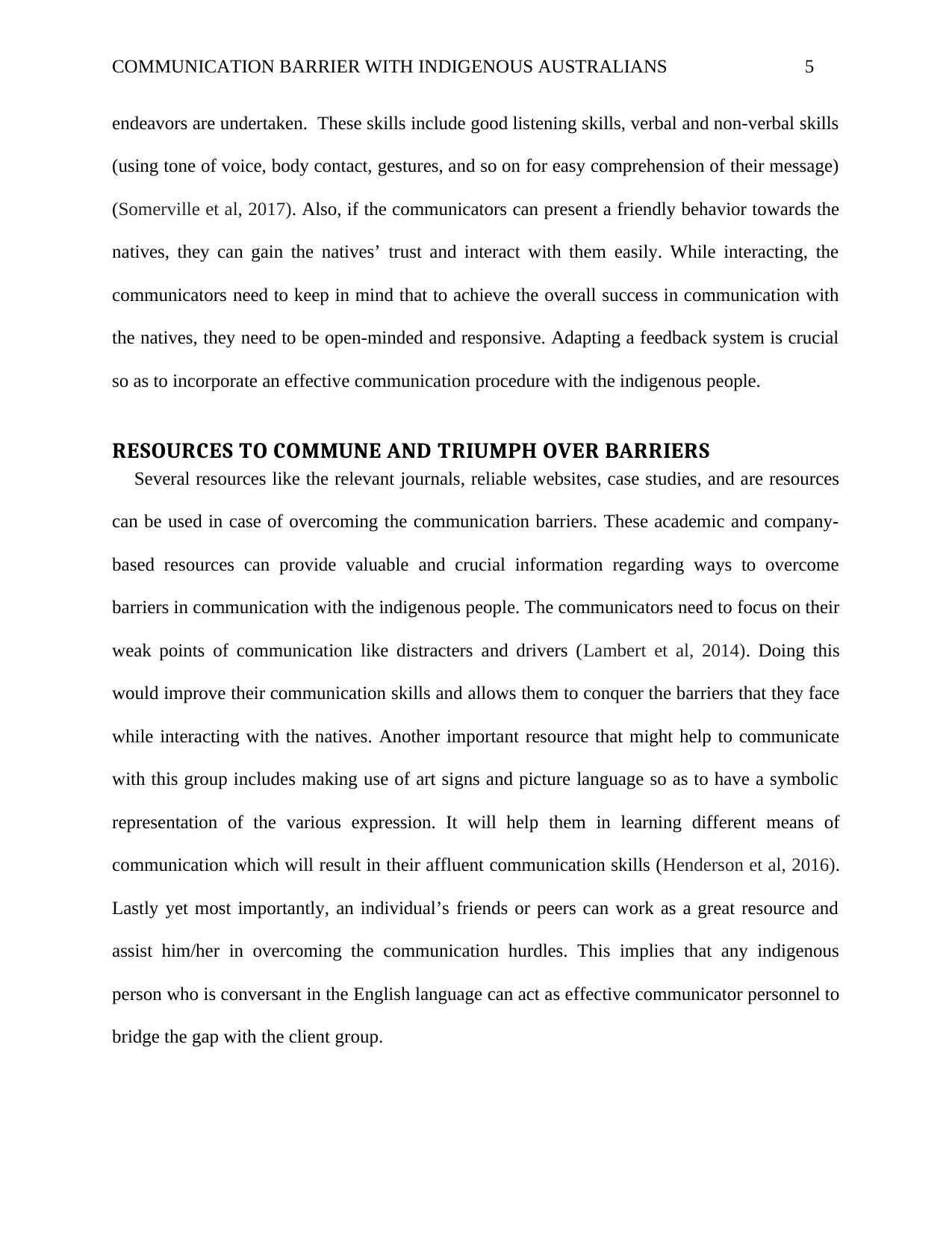
COMMUNICATION BARRIER WITH INDIGENOUS AUSTRALIANS 5
endeavors are undertaken. These skills include good listening skills, verbal and non-verbal skills
(using tone of voice, body contact, gestures, and so on for easy comprehension of their message)
(Somerville et al, 2017). Also, if the communicators can present a friendly behavior towards the
natives, they can gain the natives’ trust and interact with them easily. While interacting, the
communicators need to keep in mind that to achieve the overall success in communication with
the natives, they need to be open-minded and responsive. Adapting a feedback system is crucial
so as to incorporate an effective communication procedure with the indigenous people.
RESOURCES TO COMMUNE AND TRIUMPH OVER BARRIERS
Several resources like the relevant journals, reliable websites, case studies, and are resources
can be used in case of overcoming the communication barriers. These academic and company-
based resources can provide valuable and crucial information regarding ways to overcome
barriers in communication with the indigenous people. The communicators need to focus on their
weak points of communication like distracters and drivers (Lambert et al, 2014). Doing this
would improve their communication skills and allows them to conquer the barriers that they face
while interacting with the natives. Another important resource that might help to communicate
with this group includes making use of art signs and picture language so as to have a symbolic
representation of the various expression. It will help them in learning different means of
communication which will result in their affluent communication skills (Henderson et al, 2016).
Lastly yet most importantly, an individual’s friends or peers can work as a great resource and
assist him/her in overcoming the communication hurdles. This implies that any indigenous
person who is conversant in the English language can act as effective communicator personnel to
bridge the gap with the client group.
endeavors are undertaken. These skills include good listening skills, verbal and non-verbal skills
(using tone of voice, body contact, gestures, and so on for easy comprehension of their message)
(Somerville et al, 2017). Also, if the communicators can present a friendly behavior towards the
natives, they can gain the natives’ trust and interact with them easily. While interacting, the
communicators need to keep in mind that to achieve the overall success in communication with
the natives, they need to be open-minded and responsive. Adapting a feedback system is crucial
so as to incorporate an effective communication procedure with the indigenous people.
RESOURCES TO COMMUNE AND TRIUMPH OVER BARRIERS
Several resources like the relevant journals, reliable websites, case studies, and are resources
can be used in case of overcoming the communication barriers. These academic and company-
based resources can provide valuable and crucial information regarding ways to overcome
barriers in communication with the indigenous people. The communicators need to focus on their
weak points of communication like distracters and drivers (Lambert et al, 2014). Doing this
would improve their communication skills and allows them to conquer the barriers that they face
while interacting with the natives. Another important resource that might help to communicate
with this group includes making use of art signs and picture language so as to have a symbolic
representation of the various expression. It will help them in learning different means of
communication which will result in their affluent communication skills (Henderson et al, 2016).
Lastly yet most importantly, an individual’s friends or peers can work as a great resource and
assist him/her in overcoming the communication hurdles. This implies that any indigenous
person who is conversant in the English language can act as effective communicator personnel to
bridge the gap with the client group.
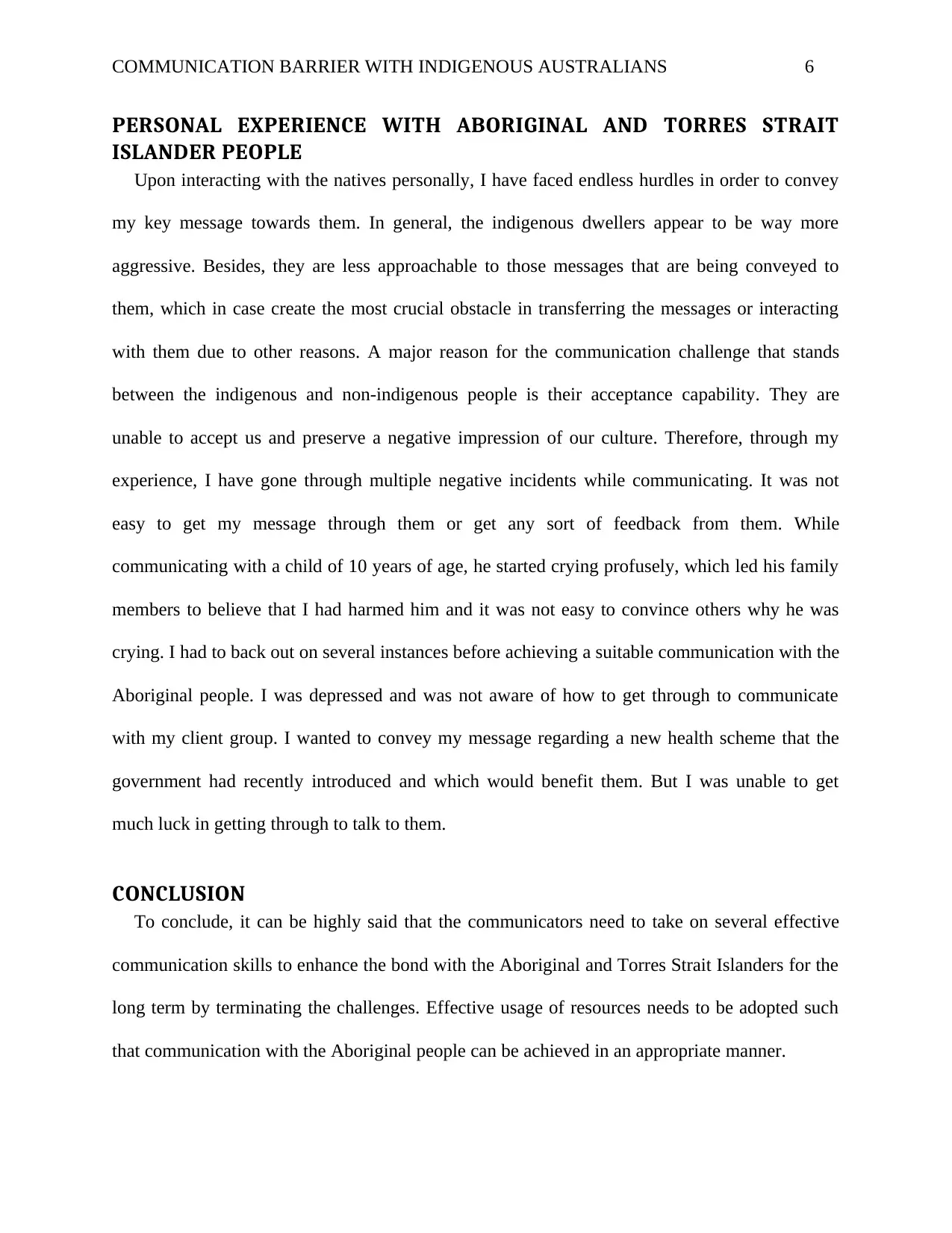
COMMUNICATION BARRIER WITH INDIGENOUS AUSTRALIANS 6
PERSONAL EXPERIENCE WITH ABORIGINAL AND TORRES STRAIT
ISLANDER PEOPLE
Upon interacting with the natives personally, I have faced endless hurdles in order to convey
my key message towards them. In general, the indigenous dwellers appear to be way more
aggressive. Besides, they are less approachable to those messages that are being conveyed to
them, which in case create the most crucial obstacle in transferring the messages or interacting
with them due to other reasons. A major reason for the communication challenge that stands
between the indigenous and non-indigenous people is their acceptance capability. They are
unable to accept us and preserve a negative impression of our culture. Therefore, through my
experience, I have gone through multiple negative incidents while communicating. It was not
easy to get my message through them or get any sort of feedback from them. While
communicating with a child of 10 years of age, he started crying profusely, which led his family
members to believe that I had harmed him and it was not easy to convince others why he was
crying. I had to back out on several instances before achieving a suitable communication with the
Aboriginal people. I was depressed and was not aware of how to get through to communicate
with my client group. I wanted to convey my message regarding a new health scheme that the
government had recently introduced and which would benefit them. But I was unable to get
much luck in getting through to talk to them.
CONCLUSION
To conclude, it can be highly said that the communicators need to take on several effective
communication skills to enhance the bond with the Aboriginal and Torres Strait Islanders for the
long term by terminating the challenges. Effective usage of resources needs to be adopted such
that communication with the Aboriginal people can be achieved in an appropriate manner.
PERSONAL EXPERIENCE WITH ABORIGINAL AND TORRES STRAIT
ISLANDER PEOPLE
Upon interacting with the natives personally, I have faced endless hurdles in order to convey
my key message towards them. In general, the indigenous dwellers appear to be way more
aggressive. Besides, they are less approachable to those messages that are being conveyed to
them, which in case create the most crucial obstacle in transferring the messages or interacting
with them due to other reasons. A major reason for the communication challenge that stands
between the indigenous and non-indigenous people is their acceptance capability. They are
unable to accept us and preserve a negative impression of our culture. Therefore, through my
experience, I have gone through multiple negative incidents while communicating. It was not
easy to get my message through them or get any sort of feedback from them. While
communicating with a child of 10 years of age, he started crying profusely, which led his family
members to believe that I had harmed him and it was not easy to convince others why he was
crying. I had to back out on several instances before achieving a suitable communication with the
Aboriginal people. I was depressed and was not aware of how to get through to communicate
with my client group. I wanted to convey my message regarding a new health scheme that the
government had recently introduced and which would benefit them. But I was unable to get
much luck in getting through to talk to them.
CONCLUSION
To conclude, it can be highly said that the communicators need to take on several effective
communication skills to enhance the bond with the Aboriginal and Torres Strait Islanders for the
long term by terminating the challenges. Effective usage of resources needs to be adopted such
that communication with the Aboriginal people can be achieved in an appropriate manner.
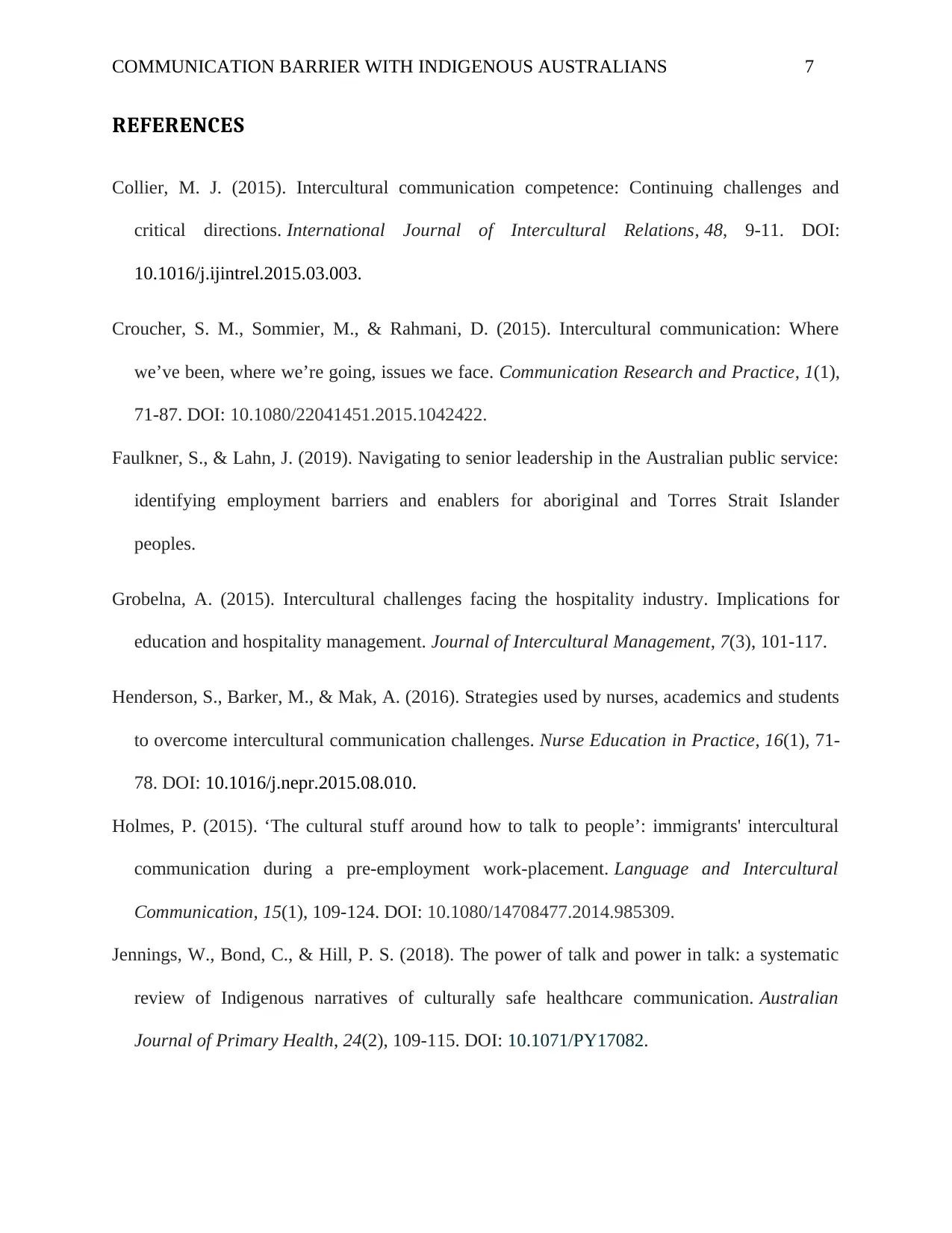
COMMUNICATION BARRIER WITH INDIGENOUS AUSTRALIANS 7
REFERENCES
Collier, M. J. (2015). Intercultural communication competence: Continuing challenges and
critical directions. International Journal of Intercultural Relations, 48, 9-11. DOI:
10.1016/j.ijintrel.2015.03.003.
Croucher, S. M., Sommier, M., & Rahmani, D. (2015). Intercultural communication: Where
we’ve been, where we’re going, issues we face. Communication Research and Practice, 1(1),
71-87. DOI: 10.1080/22041451.2015.1042422.
Faulkner, S., & Lahn, J. (2019). Navigating to senior leadership in the Australian public service:
identifying employment barriers and enablers for aboriginal and Torres Strait Islander
peoples.
Grobelna, A. (2015). Intercultural challenges facing the hospitality industry. Implications for
education and hospitality management. Journal of Intercultural Management, 7(3), 101-117.
Henderson, S., Barker, M., & Mak, A. (2016). Strategies used by nurses, academics and students
to overcome intercultural communication challenges. Nurse Education in Practice, 16(1), 71-
78. DOI: 10.1016/j.nepr.2015.08.010.
Holmes, P. (2015). ‘The cultural stuff around how to talk to people’: immigrants' intercultural
communication during a pre-employment work-placement. Language and Intercultural
Communication, 15(1), 109-124. DOI: 10.1080/14708477.2014.985309.
Jennings, W., Bond, C., & Hill, P. S. (2018). The power of talk and power in talk: a systematic
review of Indigenous narratives of culturally safe healthcare communication. Australian
Journal of Primary Health, 24(2), 109-115. DOI: 10.1071/PY17082.
REFERENCES
Collier, M. J. (2015). Intercultural communication competence: Continuing challenges and
critical directions. International Journal of Intercultural Relations, 48, 9-11. DOI:
10.1016/j.ijintrel.2015.03.003.
Croucher, S. M., Sommier, M., & Rahmani, D. (2015). Intercultural communication: Where
we’ve been, where we’re going, issues we face. Communication Research and Practice, 1(1),
71-87. DOI: 10.1080/22041451.2015.1042422.
Faulkner, S., & Lahn, J. (2019). Navigating to senior leadership in the Australian public service:
identifying employment barriers and enablers for aboriginal and Torres Strait Islander
peoples.
Grobelna, A. (2015). Intercultural challenges facing the hospitality industry. Implications for
education and hospitality management. Journal of Intercultural Management, 7(3), 101-117.
Henderson, S., Barker, M., & Mak, A. (2016). Strategies used by nurses, academics and students
to overcome intercultural communication challenges. Nurse Education in Practice, 16(1), 71-
78. DOI: 10.1016/j.nepr.2015.08.010.
Holmes, P. (2015). ‘The cultural stuff around how to talk to people’: immigrants' intercultural
communication during a pre-employment work-placement. Language and Intercultural
Communication, 15(1), 109-124. DOI: 10.1080/14708477.2014.985309.
Jennings, W., Bond, C., & Hill, P. S. (2018). The power of talk and power in talk: a systematic
review of Indigenous narratives of culturally safe healthcare communication. Australian
Journal of Primary Health, 24(2), 109-115. DOI: 10.1071/PY17082.
Paraphrase This Document
Need a fresh take? Get an instant paraphrase of this document with our AI Paraphraser
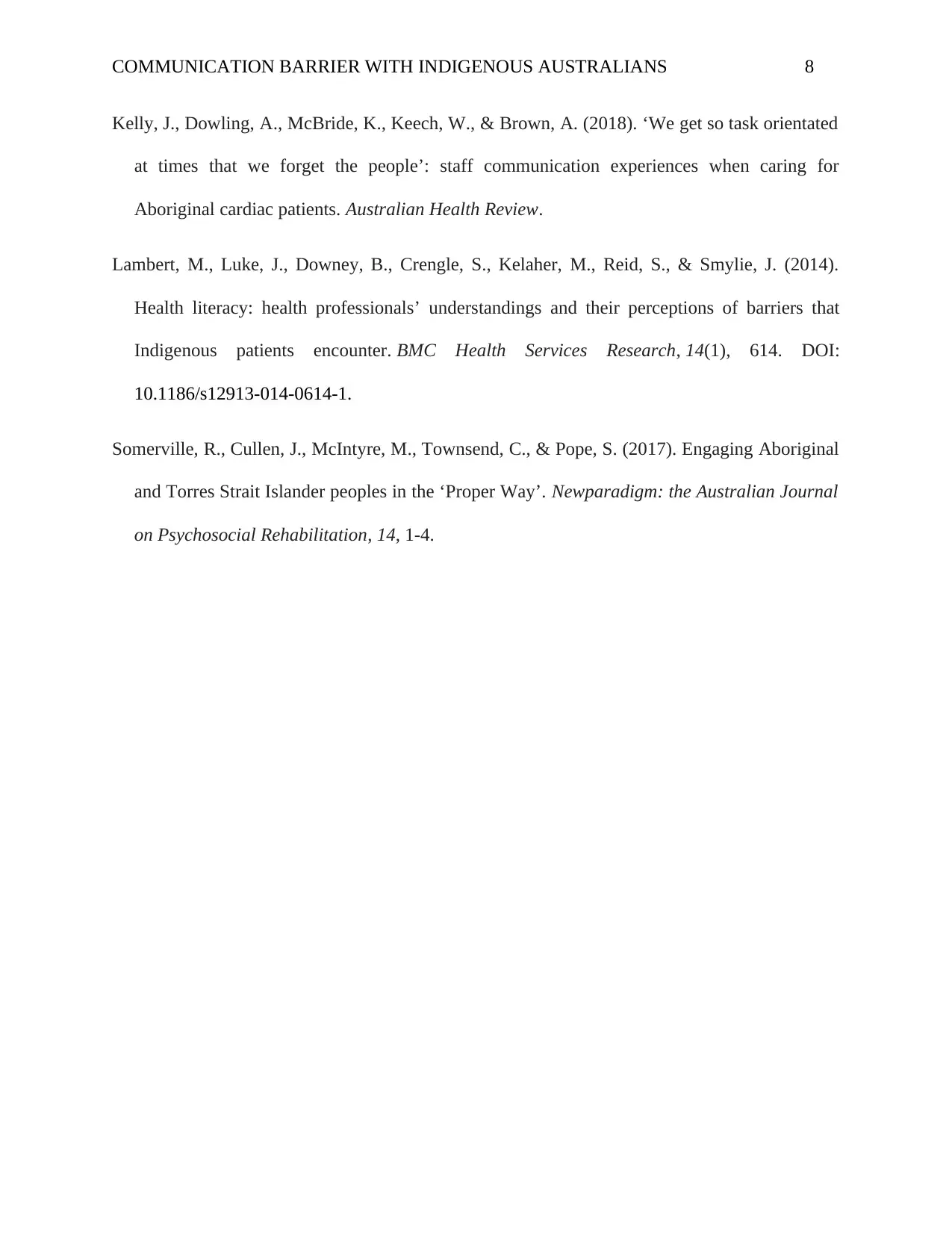
COMMUNICATION BARRIER WITH INDIGENOUS AUSTRALIANS 8
Kelly, J., Dowling, A., McBride, K., Keech, W., & Brown, A. (2018). ‘We get so task orientated
at times that we forget the people’: staff communication experiences when caring for
Aboriginal cardiac patients. Australian Health Review.
Lambert, M., Luke, J., Downey, B., Crengle, S., Kelaher, M., Reid, S., & Smylie, J. (2014).
Health literacy: health professionals’ understandings and their perceptions of barriers that
Indigenous patients encounter. BMC Health Services Research, 14(1), 614. DOI:
10.1186/s12913-014-0614-1.
Somerville, R., Cullen, J., McIntyre, M., Townsend, C., & Pope, S. (2017). Engaging Aboriginal
and Torres Strait Islander peoples in the ‘Proper Way’. Newparadigm: the Australian Journal
on Psychosocial Rehabilitation, 14, 1-4.
Kelly, J., Dowling, A., McBride, K., Keech, W., & Brown, A. (2018). ‘We get so task orientated
at times that we forget the people’: staff communication experiences when caring for
Aboriginal cardiac patients. Australian Health Review.
Lambert, M., Luke, J., Downey, B., Crengle, S., Kelaher, M., Reid, S., & Smylie, J. (2014).
Health literacy: health professionals’ understandings and their perceptions of barriers that
Indigenous patients encounter. BMC Health Services Research, 14(1), 614. DOI:
10.1186/s12913-014-0614-1.
Somerville, R., Cullen, J., McIntyre, M., Townsend, C., & Pope, S. (2017). Engaging Aboriginal
and Torres Strait Islander peoples in the ‘Proper Way’. Newparadigm: the Australian Journal
on Psychosocial Rehabilitation, 14, 1-4.
1 out of 8
Related Documents
Your All-in-One AI-Powered Toolkit for Academic Success.
+13062052269
info@desklib.com
Available 24*7 on WhatsApp / Email
![[object Object]](/_next/static/media/star-bottom.7253800d.svg)
Unlock your academic potential
© 2024 | Zucol Services PVT LTD | All rights reserved.





